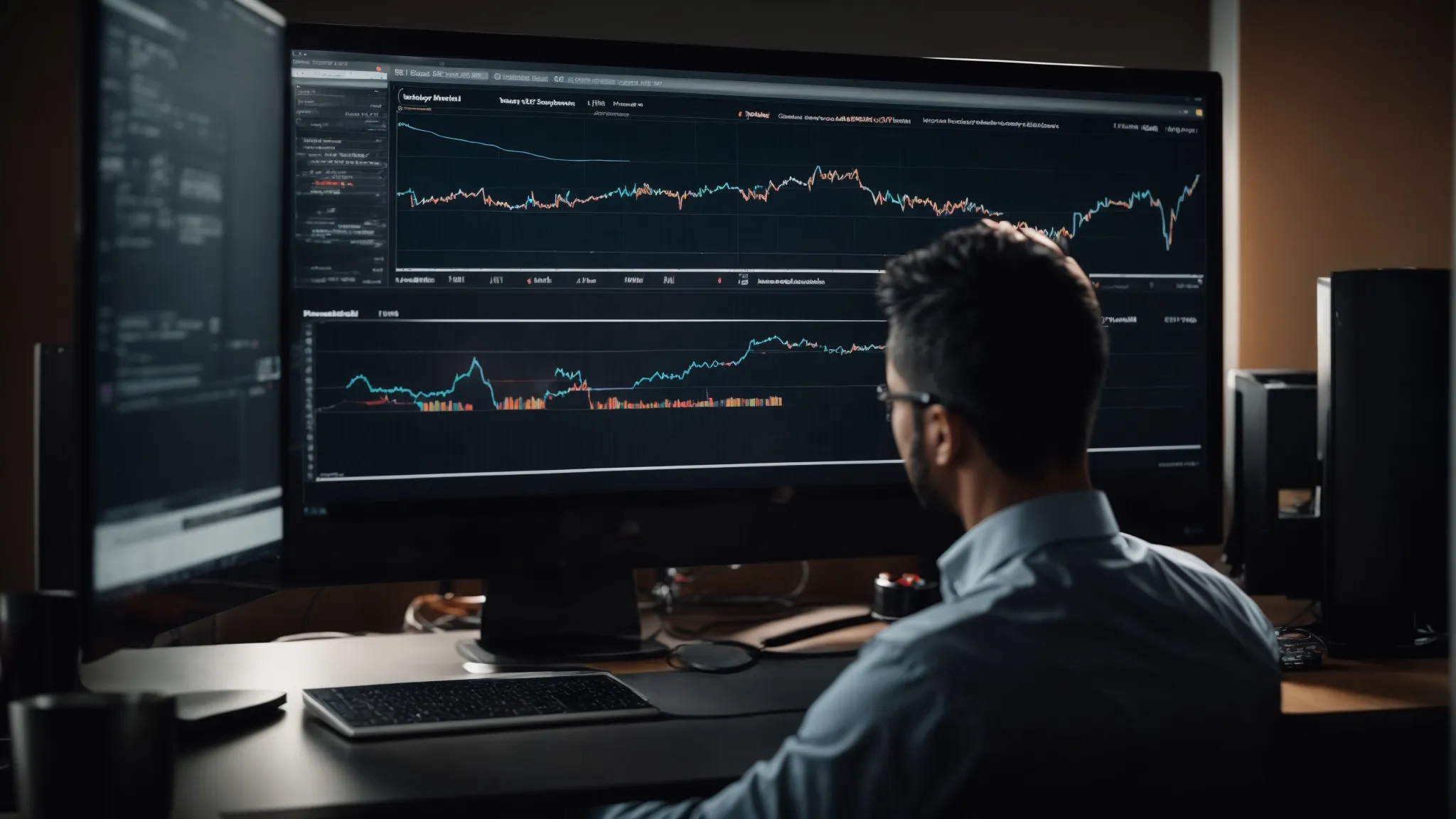Google Search Algorithm Updates
Understanding the Latest Google Search Algorithm Updates Navigating the evolving landscape of Google’s search algorithm updates proves essential for any SEO expert seeking to maintain or improve […]
Understanding the Latest Google Search Algorithm Updates
Navigating the evolving landscape of Google’s search algorithm updates proves essential for any SEO expert seeking to maintain or improve search engine visibility.
From the nuances of Core Web Vitals that prioritize page experience to the integration of sophisticated AI like BERT, these adjustments underscore a shift towards a more user-centric and intelligent search framework.
Experts must now consider E-a-T principles—Expertise, Authority, and Trustworthiness—as critical components in their SEO content strategy, all while keeping pace with candid insights from Google’s SEO community.
Keep reading to discover how to effectively adjust your content strategy in the wake of these significant search algorithm updates.
Key Takeaways
- Google’s Search Algorithm Updates Prioritize User Experience, With Significant Emphasis on High-Quality, Expert Content
- BERT and Other AI Technologies Have Advanced Google’s Understanding of Natural Language, Refining the Alignment Between User Intent and Search Results
- E-a-T (Expertise, Authority, and Trustworthiness) Is Essential for Achieving Credibility and Higher Search Rankings in Google’s Evaluation Framework
- SEO Strategies Should Be Adaptive and Informed by Community Insights and Algorithmic Trends for Competitive Advantage
- Content Strategies Must Be Revised Post-Update to Stay Relevant and Authoritative in Response to Changes in Search Intent and Algorithm Priorities
Breakdown of Recent Google Algorithm Changes
In the ever-evolving landscape of digital marketing, search engines remain pivotal for ensuring visibility and driving web traffic.
Recent updates from Google’s search algorithm have introduced substantial changes to the digital arena, affecting countless websites and SEO strategies.
Professionals must now scrutinize these developments, from the nuances of Panda and Penguin to the intricacies of SpamBrain and BERT, to surmise their implications profoundly.
The forthcoming dialogue elucidates the nature of these updates, assessing their influence on search rankings, and charts the progression of algorithmic rollouts in an extensive manner.
In delving into these updates, organizations and SEO experts, such as those at LinkGraph utilizing the SearchAtlas SEO tool, can refine their strategies to align with the current demands of search engines, thereby maintaining or enhancing their digital presence.
Identifying the Scope of the Latest Updates
The latest Google search algorithm updates have ushered in a new era for SEO professionals who aim to optimize webpages for enhanced search visibility. Key updates include the Page Experience Update, which now factors in various user engagement metrics, and the Product Reviews Update that prioritizes in-depth, expert knowledge over superficial content.
Understanding these updates necessitates a deep dive into Google’s algorithm modifications: the Helpful Content Update seeks to reward content designed primarily for users over search engines, while the Spam Update reinforces measures against web pages that violate Google’s quality guidelines.
- Page Experience Update – Emphasizes user interaction signals
- Product Reviews Update – Values detailed expert analysis
- Helpful Content Update – Incentivizes user-centric material
- Spam Update – Intensifies actions against low-quality content
Analysing the Impact on Search Ranking
The recent search algorithm updates by Google have set a new stage for how SEO effectiveness is measured. Aspects such as the Page Experience Update directly affect rankings by prioritizing websites that offer intuitive navigation and swift loading speeds, marking a distinct shift towards user experience as a ranking criterion.
Analysis of these updates suggests a sweeping impact on search rankings, with significant emphasis on the value of qualitative, authoritative content. Specifically, the Product Review and Helpful Content updates have recalibrated what it means to provide value to the user, favoring content that satisfies searcher intent with depth and insight:
| Update | Focus | Impact on Rankings |
|---|---|---|
| Page Experience | User Interaction | Increases visibility for user-friendly sites |
| Product Reviews | Expert Analysis | Elevates content with comprehensive expertise |
| Helpful Content | User-focused Material | Rewards genuinely informative content |
| Spam Update | Quality Guidelines | Penalizes sites engaging in dubious practices |
Understanding the Timeline of Rollouts
The schedule of Google’s algorithm rollouts is a critical factor for SEO professionals who vigorously monitor these changes to adapt strategies promptly. With each release—such as the expansive Core Updates or the nuanced Medic Update—comes a potential shift in the SEO ecosystem, demanding expedited and thoughtful response from vigilant site owners and marketers.
LinkGraph, recognized for its SEO acumen, harnesses the SearchAtlas SEO tool to guide clients through these pulsating changes. The company’s experts deftly analyze the effects of each update—be it the expansive Core Algorithm Update or the specific adjustments of the Product Review Update—to provide efficient recalibration of SEO tactics, ensuring client webpages maintain optimal performance in search results.
Core Web Vitals and User Experience Focus
The introduction of Core Web Vitals by Google heralds a significant transition towards a more user-centric paradigm in search engine optimization.
These critical metrics represent a shift in how site performance and user experience influence search rankings.
The latest updates underscore the growing importance of user experience, embedding it as a key factor alongside traditional SEO touchpoints.
This transformative move obliges webmasters to deploy tools and strategies adept at quantifying and enhancing their website’s Core Web Vitals, ensuring they not only meet but exceed the benchmark set by Google for a stellar user experience.
What Core Web Vitals Mean for Webmasters
For webmasters, Core Web Vitals have become indispensable gauges of site health, as these metrics are now critical benchmarks in assessing the user experience one’s website delivers. Emphasizing factors like load time, interactivity, and visual stability, adherence to Core Web Vitals directly correlates to a website’s ability to rank favorably in Google’s search results.
LinkGraph’s adept utilization of the SearchAtlas SEO tool empowers site owners to Pinpoint Areas where their web properties may fall short of these vital parameters. By leveraging such insights, webmasters can implement precise improvements, ensuring their sites not only comply with Google’s user-focused criteria but also offer visitors a seamless and engaging online experience.
How User Experience Is Weighed in Latest Updates
The augmentation of user experience as a significant ranking factor in the latest Google search algorithm updates serves as testament to the evolving nature of SEO. User engagement metrics such as mobile-friendliness, safe browsing, HTTPS, and intrusive interstitial guidelines have become critical in dictating the prominence of web pages within search results.
- Mobile-friendliness assesses the ease of navigation and readability on smartphones and tablets.
- Safe browsing evaluates a website’s security and the protection it offers against malicious activities.
- HTTPS measures the use of secure, encrypted connections to safeguard data transmission.
- Intrusive interstitial guidelines discourage the use of pop-ups that obstruct users’ view of content.
Google’s incorporation of these user experience considerations ensures that websites prioritizing their visitors’ needs are recognized favorably in rankings. This shift underscores the transition from purely technical SEO aspects to a more holistic approach, championing the overall satisfaction of the end-user.
Tools to Measure and Improve Core Web Vitals
Investigating and optimizing Core Web Vitals requires robust tools capable of delivering precise metrics and actionable insights. LinkGraph acknowledges this need and integrates the SearchAtlas SEO tool into their suite of SEO services to provide comprehensive Core Web Vitals reporting, affording clients a clear understanding of how their websites perform against these pivotal user experience benchmarks.
Advancements in SEO analytics have evolved, enabling site owners to identify and remedy deficits in site performance that may impede user satisfaction. LinkGraph’s SEO services, through Meticulous Analysis, assist in enhancing loading speeds, interactive responsiveness, and visual stability, contributing to elevated Core Web Vitals scores and improved search rankings:
| Core Web Vital | Factor | LinkGraph’s Approach |
|---|---|---|
| Loading | Load Time | Analyzes and optimizes speed metrics |
| Interactivity | Responsiveness | Identifies bottlenecks to improve user interaction |
| Visual Stability | Layout Shifts | Addresses design elements for smoother browsing |
The Rise of AI in Search: BERT and Beyond
Amid the unfolding panorama of SEO, artificial intelligence has become a seismic force, reshaping the very foundations of search query processing and user interaction on search engines.
The introduction of BERT (Bidirectional Encoder Representations from Transformers) heralds a monumental leap in machine understanding of natural language, galvanizing Google’s capacity to decipher the intricacies and context of user queries.
This sophisticated AI algorithm is merely the spearhead of a vanguard of advanced machine learning models poised to redefine search engine algorithms.
Content creators and SEO strategists are urged to stay ahead, ensuring their content harmonizes with the emerging AI-driven landscape while upholding the caliber of information and usability users demand.
The ensuing discussion will peel back the layers of BERT’s pivotal role, scrutinize the evolution of AI in algorithm refinement, and equip one with the acumen to tailor content for the AI-driven search algorithms of tomorrow.
Insight Into BERT’s Role in Understanding Queries
Google’s implementation of BERT, which stands for Bidirectional Encoder Representations from Transformers, has revolutionized the search landscape by enabling a more nuanced understanding of the context within user queries. It scrutinizes the entirety of a query to grasp subtleties that prior models may have overlooked, optimizing for a more accurate alignment between user intent and search results.
| Aspect of Search | Impact of BERT |
|---|---|
| Understanding Context | Delves into the full context of search phrases to discern user intent more effectively |
| Result Relevance | Enhances the precision of search results by capturing the nuance in queries |
By incorporating this sophisticated AI, the realm of SEO enters a new echelon, prompting strategists to prioritize content relevance and authority in their approach. LinkGraph, leveraging the analytical prowess of the SearchAtlas SEO tool, aligns its strategies with such advancements, ensuring that content resonates profoundly with both BERT’s algorithms and the pertinent inquiries of users.
The Evolution of AI in Google’s Algorithm
The implementation of AI technologies like BERT underscores Google’s ongoing commitment to enhancing the search experience. This translates to Google’s algorithms becoming increasingly adept at interpreting and processing natural language, bringing them closer than ever to human-like understanding.
As AI continues to evolve, Google’s algorithms are expected to become more predictive and insightful, further refining the accuracy with which they match user intent to content:
- Algorithms will likely advance towards predicting searcher needs, even before they fully articulate them in queries.
- Machine learning models will become more efficient, filtering out irrelevant search results with greater precision.
- Future updates may integrate even deeper learning capabilities, potentially anticipating and shaping user search behaviors.
The trajectory of these developments signifies that SEO professionals, such as the team at LinkGraph, need to stay abreast of AI progressions to maintain competitive advantage. These enhancements in Google’s algorithms call for an SEO approach anchored in advanced data analysis and user-focused content strategies.
Preparing Content for AI-driven Search Algorithms
Adapting content for AI-driven search algorithms requires an acute awareness of linguistic precision and topical clarity. Content creators must now ensure their work is tailored to align with how AI systems, like Google’s BERT, interpret context and user intent to deliver pertinent search results.
The crafting of SEO strategies in this AI-focused paradigm necessitates a forward-thinking approach where the latent needs and questions of users are anticipated and expertly addressed through comprehensive and contextually rich content.
| SEO Consideration | Importance in AI-Driven Search | Actionable Strategy |
|---|---|---|
| Linguistic Precision | Crucial for Context Understanding | Implement NLP techniques to enhance content relevance |
| Topical Clarity | Key to User Intent Alignment | Develop content that deeply covers subject matter |
| User-focused Material | Central for Engaging Content | Incorporate user experience research into content creation |
Understanding E-a-T and Its Significance
Amidst the shifting paradigms of search engine optimization, Google’s emphasis on Expertise, Authority, and Trustworthiness—collectively known as E-a-T—has become a cornerstone of their ranking framework.
With search engines increasingly prioritizing high-quality, reliable content, E-a-T stands as a critical measure for websites aspiring to ascend in search rankings.
Mastering E-a-T requires a robust understanding of its constituents and the creation of deliberate strategies that underline the credentials, reputation, and credibility of a website’s content.
LinkGraph, renowned for its precision-focused SEO services, paves the way for site owners to enhance their online authority through strategic improvements, backed by success stories that showcase the tangible benefits of E-a-T optimization.
The Definition of Expertise, Authority, and Trustworthiness
Expertise, Authority, and Trustworthiness, commonly referred to as E-A-T, are pivotal components that frame Google’s guidelines for website evaluation. These factors collectively influence how the search engine perceives the credibility of a website and its content.
Expertise represents the depth of knowledge demonstrated by the content creator, Authority underscores the site’s reputation within its field, and Trustworthiness refers to the accuracy and legitimacy of the information presented. Each element contributes to a website’s ability to rank well within the search results:
- Expertise showcases an individual’s or organization’s comprehensive understanding of the subject matter.
- Authority is evidenced by external indicators such as backlinks from reputable sites and mentions by industry leaders.
- Trustworthiness is affirmed through transparent practices, including clear author attribution and the presence of a privacy policy.
Strategies to Improve Your Website’s E-a-T
To bolster a website’s E-a-T, owners must first ensure that content is authored by individuals with verifiable expertise in their respective fields. This can be achieved by producing and publishing materials that highlight the author’s credentials, drawing a direct connection between their knowledge and the information they provide.
Building authority requires consistent outreach and networking to secure quality backlinks, as these serve as endorsements from other credible sources. It’s important to foster a presence within the community that reflects well on the brand, leading to natural citations and authority-building opportunities:
- Cultivate relationships with industry influencers for guest posts and collaborative content.
- Engage in speaking opportunities at conferences or webinars to assert thought leadership.
- Contribute valuable insights to discussions and forums to demonstrate knowledge.
When focusing on website trustworthiness, transparency is critical. Maintaining an up-to-date privacy policy, providing clear contact information, and showcasing trusted badges or certifications can reassure users and Google alike of a site’s legitimacy. Altogether, these steps forge a stronger E-a-T profile that search engines value.
Case Studies: E-a-T Implementation and Results
In the realm of search engine optimization, the transformative impact of E-a-T is best illustrated through practical case studies. One notable example involves a healthcare website that experienced a dramatic climb in search rankings after revamping its content to showcase the medical qualifications of its authors and ensuring all health advice was backed by scientific research and consensus.
| Website Sector | E-a-T Strategy | SEO Outcome |
|---|---|---|
| Healthcare | Highlighting Authors’ Credentials; Scientifically-backed Content | Significant Rise in Search Rankings |
Another Compelling Case comes from a financial advisory firm that strengthened its E-a-T profile by enhancing its website security measures, publishing white papers and detailed market analyses from certified experts, which collectively led to a surge in organic search traffic and improved brand credibility.
Insights From Google’s SEO Community Reports
In a discipline that perpetually adapts to the rhythm of technological advancements, the valued voices from Google’s SEO community offer a beacon for navigating the tumultuous waves of search algorithm updates.
Distilling insights from numerous professionals, these community reports provide a wealth of shared knowledge, enabling discerning SEO experts to recalibrate strategies with precision.
Summarizing key findings from ongoing dialogues, interpreting how these insights can sculpt an effective SEO blueprint, and detecting patterns in algorithm impacts across different sectors becomes crucial.
Exploiting such cumulative intelligence equips brands like LinkGraph, with its commitment to stellar SEO services via the SearchAtlas SEO tool, to not only withstand but thrive amidst the current search engine dynamics.
Summarizing Key Findings From Community Feedback
Professionals within the SEO arena are discerning a pattern through Google’s SEO community reports, which provide a pulse on the prevailing industry sentiments. These findings reveal a general emphasis on the importance of content quality, with continuous reminders that the bolstering of web presence goes hand in hand with delivering genuine value to the audience.
Additionally, the collected feedback underscores adaptability as an essential trait for SEO success. It’s clear from the discussions that Google’s algorithms are favoring websites with agile SEO strategies that can rapidly pivot to accommodate new guidelines and updates:
| Community Insight | SEO Element | Adaptability Requirement |
|---|---|---|
| Content Quality Emphasis | Content Creation | Enhancing Value Delivery |
| Agility in Strategy | SEO Planning | Responsive Adjustments |
How to Use Community Reports to Guide Your SEO Strategy
Interpreting the wealth of information within Google’s SEO community reports empowers LinkGraph’s SEO services to adapt swiftly and strategically. The reports’ collective expertise facilitates the distillation of current trends and user behaviors into actionable insights, allowing SEO professionals to tailor their strategies to meet the latest algorithmic preferences with an informed approach.
SEO strategies grounded in community report analysis position LinkGraph’s clients for improved search engine relevance and performance. These SEO insights, in concert with the sophistication of the SearchAtlas SEO tool, enable the crafting of data-driven, Adaptive Strategies that resonate with both the search engines and the target audience, thus bolstering online visibility and engagement.
Recognizing Patterns in Algorithm Impacts Across Industries
Industry-specific analysis of algorithm impacts reveals discernible trends that SEO experts at LinkGraph carefully monitor to optimize client performance. Variations in algorithm effects across e-commerce platforms, local service providers, and content publishers highlight the need for bespoke SEO services tailored to sector-specific nuances.
LinkGraph’s adept SEO services are informed by this sectoral comprehension, ensuring that strategies are not merely reactive but strategically anticipative. Such insights manifest in advanced SEO tactics that align with industry trends and consumer search behaviors, thus securing clients’ competitive edge in their respective markets.
How to Adapt Content Strategy Post Update
In the wake of Google’s latest search algorithm updates, businesses and SEO specialists are tasked with reevaluating their content strategies to preserve and enhance their online presence.
This imperative mandates a series of meticulous content audits, realignments of material to fulfill updated search intent requirements, and the study of successful content transformations that have prospered under the new algorithmic conditions.
These endeavors, collectively, form the groundwork necessary for websites to remain relevant and authoritative in the eyes of both users and the evolving search algorithm.
Content Audit Recommendations Post-Algorithm Update
Post-update content audits are pivotal for aligning with the evolving preferences of Google’s search algorithm. LinkGraph’s SEO experts recommend an exhaustive analysis of existing website content through the lens of the latest algorithmic changes, identifying any disparities and revising content to ensure it satisfies the current ranking factors and user search intent.
Employing the SearchAtlas SEO tool, LinkGraph aids clients in scrutinizing the performance metrics of their content, spotlighting opportunities for refinement. This meticulous approach enables the adaptation of content strategies to embrace Google’s latest updates, fortifying the vitality and relevance of online material in the quest for optimal search engine positioning.
Aligning Content With the Updated Search Intent Parameters
Adapting content to meet updated search intent parameters involves a deliberate refinement of topics and delivery to align with user expectations. LinkGraph, through its specialized SEO services and the SearchAtlas SEO tool, helps clients discern and interpret these shifts in search intent, allowing for the calibration of content that resonates more accurately with target audiences.
With search engines prioritizing content that comprehensively addresses users’ needs, LinkGraph’s expertise in on-page SEO services is instrumental in reconstructing web content to address specific queries. These strategic enhancements are designed to elevate the user experience by providing clear, focused answers to search queries, thereby improving the alignment with Google’s evolved search intent paradigms.
Case Studies on Successful Content Strategy Pivots
In a landscape shaped by Google’s intricate search algorithm updates, certain brands have exemplified adaptability, showcasing successful content strategy pivots. A notable case involved a culinary platform that, by shifting its focus to in-depth recipe guides and nutritional insights, witnessed a substantial boost in organic traffic, attributed to alignment with the Helpful Content Update’s emphasis on depth and user value.
Another example echoes from the tech industry, where a gadget review website restructured its content to offer detailed comparisons and technical expertise, thus adhering to the Product Reviews Update. This strategy pivot culminated in a notable elevation of its authority within the niche, cementing its standing in the search rankings and echoing the power of dedicated E-A-T compliance.
Conclusion
In conclusion, staying abreast of the latest Google search algorithm updates is crucial for SEO professionals and businesses aiming to maintain high search rankings.
Evident shifts towards prioritizing user experience, as showcased by the Page Experience and Core Web Vitals updates, along with the push for high-quality, relevant content through the Helpful Content and Product Reviews updates, signify the need for a user-centric and content-focused SEO approach.
The rise of AI, particularly with BERT, demands an appreciation for natural language and context in content strategies.
Additionally, the E-A-T framework has become a mainstay, underscoring the importance of expertise, authority, and trustworthiness in enhancing web presence.
By actively employing tools like the SearchAtlas SEO tool and heeding insights from Google’s SEO community, LinkGraph and other savvy SEO practitioners can effectively navigate and thrive amidst the ongoing evolution of search engine dynamics.















































































